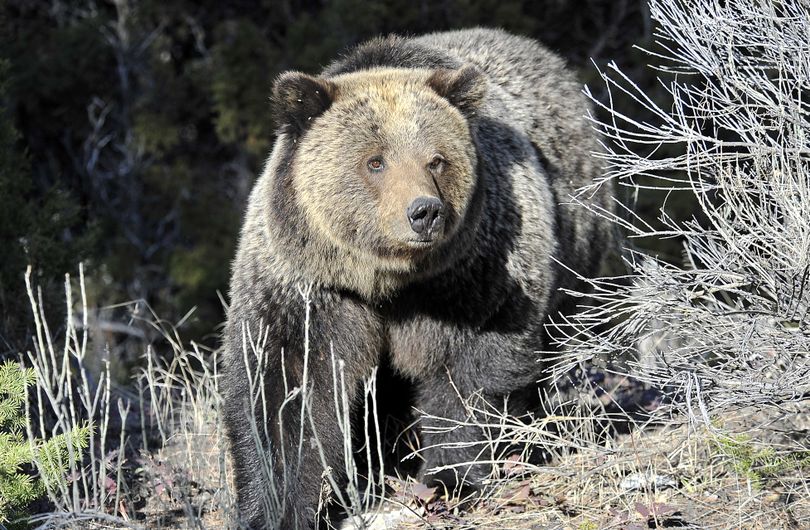Feds say Yellowstone grizzlies no longer threatened; delisting proposed

UPDATED 1:08 p.m. with statement from U. S. Fish and Wildlife Service at end of post.
ENDANGERED SPECIES -- In a move that could pave way for limited hunting, grizzly bears in the Yellowstone region are being recommended for delisting from Endangered Species Act protections.
Federal wildlife officials say this marks a major milestone in the recovery effort for Yellowstone-area grizzly bears.
An announcement is planned for this afternoon by the U.S. Fish and Wildlife Service, according to wildlife groups and the Associated Press. (See statement posted below at 1:05 p.m.)
An estimated 700-1000 grizzlies live in the Yellowstone region of Montana, Wyoming and Idaho.
Historically grizzly bears ranged from Alaska to Mexico, with an estimated 50,000 bears occupying the western half of the contiguous United States. With European settlement of the American West, they were shot, poisoned and trapped to near extinction.
Grizzlies were given federal protections as a threatened species in 1975.
Today, 1,500 to 1,800 grizzlies are found in five isolated populations in the northern Rocky Mountains and North Cascades. Federal wildlife managers say the Yellowstone-region bears are a recovered Endangered species success story.
State officials have been pressuring the federal government to lift protections. They want to allow trophy hunting of the animals outside the park.
Conflicts between humans and grizzly bears have been on the rise, including six people fatally mauled since 2010. A record 59 bears were killed by humans last year, often by wildlife managers following attacks on livestock.
Grizzly attacks on big-game hunters in the region have been an issue in recent years.
Opponents say lifting protections could be a setback for a population that’s still relatively isolated and faced with diminishing food supplies due to factors including climate change.
Grizzly bears can live to 30 years in the wild. Males can weigh up to 1,700 pounds, while females can weigh up to 800 pounds. Grizzlies are omnivores, eating fruits, berries, grasses, and roots, along with fish like salmon, rodents, carrion, and hoofed animals like moose, elk, caribou and deer.
The U.S. Fish and Wildlife Service issued the following statement at 1 p.m.
In response to the successful recovery of one of the nation’s most iconic animals, the U.S. Fish and Wildlife Service (Service) today proposed to remove the grizzly bear in the Greater Yellowstone Ecosystem from the Federal Lists of Endangered and Threatened Wildlife.
The restoration of the grizzly bear in Montana, Wyoming and Idaho during the last three decades stands as one of America’s great conservation successes—a testament to the value of the Endangered Species Act (ESA) and the strong partnerships it drives. The Yellowstone grizzly bear population has rebounded from as few as 136 bears in 1975 to an estimated 700 or more today.
“The recovery of the Yellowstone grizzly bear represents a historic success for partnership-driven wildlife conservation under the Endangered Species Act,” said Service Director Dan Ashe. “Our proposal today underscores and celebrates more than 30 years of collaboration with our trusted federal, state and tribal partners to address the unique habitat challenges of grizzlies. The final post-delisting management plans by these partners will ensure healthy grizzly populations persist across the Yellowstone ecosystem long into the future.”
To ensure robust monitoring of Yellowstone grizzly bears, balanced management and effective conservation going forward, the Service is also releasing two other documents for public comment, a draft supplement to the 1993 Grizzly Bear Recovery Plan for the Yellowstone grizzly bear population, and a draft conservation strategy. These detail how both grizzly bears and their habitat will be managed in a post-delisting environment.
“Even with this proposed delisting, the Service remains committed to the conservation of the Yellowstone grizzly bear, and will stay engaged to ensure that this incredible species remains recovered,” Ashe said. “We will continue to be part of a strong monitoring program, implementation of the conservation strategy, and partnership with our state and federal partners. We are look forward to hearing from the public about the proposal and consulting with Native American tribes.”
Population and habitat monitoring efforts undertaken by the Interagency Grizzly Bear Committee Study Team indicate that grizzly bears have more than doubled their range since the mid-1970s. They now occupy more than 22,500 square miles of the Yellowstone ecosystem, an area larger than the states of New Hampshire, Massachusetts and Rhode Island combined. Stable population numbers for grizzlies for more than a decade also indicate that the Yellowstone ecosystem is at or near its carrying capacity for the bears.
Determining recovery is based on more than just the number of bears in the ecosystem. It includes the quantity and quality of habitat, adequate regulatory mechanisms to maintain a healthy and viable population, and a good balance of male and female bears that are well-distributed throughout the ecosystem.
The proposed rule, and the supporting documents, will publish in a couple days in the Federal Register. The Service will be seeking review and comment by the public, other federal and state agencies, and independent scientists. Comments will be accepted for 60-days after publication. You can submit electronically at http://www.regulations.gov. In the Search box, enter Docket Number FWS–R6–ES–2016–0042, and then click on the “Comment Now!” button.
Comments will also be accepted via U.S. mail or hand-delivery: Public Comments Processing, Attn: Docket No. FWS–R6–ES–2016–0042, U.S. Fish and Wildlife, MS: BPHC, 5275 Leesburg Pike, Falls Church, VA 22041-3803. Please note that submissions merely supporting or opposing a potential delisting, without supporting documentation, will not be considered in making a determination.
The Service will post all information received on http://www.regulations.gov. This generally means that we will post any personal information that is provided. To view the complete Federal Register notice that publishes, visit http://www.fws.gov/mountain-prairie/es/grizzlybear.php. The ESA is an essential tool for conserving the nation’s most at-risk wildlife, as well as the land and water on which they depend for habitat. The ESA has saved more than 99 percent of the species listed from the brink of extinction and has served as the critical safety net for wildlife that Congress intended when it passed the law 40 years ago. The Obama Administration has delisted more species due to recovery than any prior administration, including the Oregon Chub, Virginia northern flying squirrel and brown pelican.
Learn more about grizzly bears at NWF.org/Grizzly.
